Pekka Buttler, June 2024
This Article extends on (and replaced) a previous JAPB article that focused only on the Mamiya Z mount. The reason for gathering all the Mamiya 35 mm SLR mounts in one article is that seeing them all as part of a chronological story is likely to help understanding their relationships.
Moreover, it will illustrate the heroic tragicomedy of Mamiya as a 35 mm SLR maker.
A brief history of time Mamiya 35 mm SLR mounts
Mamiya is today most well-known for its medium format TLR’s, SLR’s (Mamiya 645, Mamiya 67 RB and 67 RZ), and medium format rangefinders (Mamiya 6 and Mamiya 7), but Mamiya was also heavily involved in the 35 mm format – both in lenses and SLR manufacture.
One indicator of Mamiya’s strong involvement in the 35 mm SLR market from 1961 to 1984 was that Mamiya often were at the forefront of technological development (First SLR to offer TTL spot metering, first Japanese camera manufacturer to implement electronic lens-body communication). Also, Mamiya was a highly trusted OEM manufacturer for major 35 mm brands – Japanese (e.g. Nikon) and European (Rollei-Voigtländer) alike.
However, what Mamiya lacked in the 35 mm SLR business was a resounding commercial success. Moreover, Mamiya 35 mm SLRs never seemed to sell as well as one would – based purely on comparing specifications – have reasonably assumed. While one could argue that key Mamiya contributions (such as spot metering) were simply not as attractive as Mamiya would have liked, I’d argue that a key reason for Mamiya’s lack of success is a fundamental lack of dependability. In roughly 20 years (1961–1980) Mamiya used altogether 7 different mounts1 for their 35 mm SLRs and 6 of these were proprietary, closed mounts. Not only does this (to me) indicate a company lacking a clear technological vision, but such flakiness must – in the long run – start impacting consumers’ willingness to invest heavily in such a system, even if Mamiya seems to have tried to partially address the problem2.
But allow me to return briefly to substantiate my claim that Mamiya lacked a clear technological vision. Listen to this:
– in 1961 Mamiya introduces its first SLR. It uses a variant of the Exakta Mount 3
– also in 1961 Mamiya introduces a leaf shutter SLR that uses a unique mount.
– in 1964 Mamiya introduces an SLR using the standard M42 mount. All previous mounts are dropped.
– in 1971 Mamiya drops all M42 lenses & cameras and introduces a proprietary bayonet mount.
– In 1974 Mamiya drops that bayonet mount and reverts – sort of – to M42 bodies and lenses, but introduces a proprietary variant of the M42 mount. These M42 lenses cannot be used on other M42 cameras.
– In 1978 Mamiya finally drops the M42 mount for good and goes back to using a proprietary bayonet mount, but it’s not the same as earlier. It’s a new bayonet mount.
– In 1980 Mamiya drops the proprietary bayonet mount that they introduced only two years earlier, and introduce … (drum roll) … another proprietary bayonet mount that kind-of shares the same bayonet, the same flange focal distance, but little else.
Do you think this is confusing? You’re not alone. But wait, there’s more.
Lens mounts are typically named either after the first camera to use that mount (think: Nikon F), or based on the manufacturer’s wish to have their system named a specific way (Canon EF lenses for the EOS cameras). And Mamiya has not made it easy, often naming their initial cameras in one way (e.g. AutoXTL) and their lens family a different way (lenses for the AutoXTL go by the name ‘ES’; lenses for the NC series of cameras go by the name ‘CS’ ; Lenses for the final, Z-series of cameras were first called ‘E’, only to be renamed ‘EF’ only to be renamed ‘E […] S’). No wonder then that there is not a some confusion regarding the names of the various families of lenses…
Hopefully the table below will shed some light on the matter.
Furthermore, for the sake of our sanity, JAPB will also use its own fusion names for all these lens mounts. For instance instead of having to say “the Mamiya XTL (also known as ES) mount, we will simply refer to it as the XTL/ES mount4.
| Camera series (years) | Camera models | Lens mount / mount name | Lens type name | Lens type on lens’ name ring (examples) | JAPB name |
|---|---|---|---|---|---|
| Prismat NP (61–63) | Prismat NP | Exakta (proprietary variant) | F.C. | • Mamiya-Sekor F. C. | Prismat-Exakta |
| Prismat PH/CPH (61–63) | Prismat PH, Prismat CPH | Unique, unnamed mount | F.C. | • Mamiya-Sekor F. C. | Prismat-Leaf shutter |
| CP (64–66) | CP | M42 (standard variant) | None (sometimes referred to as Mamiya CP M42) | • MAMIYA-SEKOR | standard M42 |
| TL & DTL (66–70) | 500TL, 1000TL, 500DTL, 1000DTL, 2000DTL | M42 (standard variant) | None (sometimes referred to as Mamiya TL&DTL M42) | • AUTO mamiya/sekor | standard M42 |
| XTL & X-1000 (71–75) | AutoXTL, Auto X-1000 | Mamiya XTL (a.k.a. Mamiya X) | ES | • AUTO mamiya/sekor ES | XTL/ES |
| SX, MSX, DSX (74–78) | MSX 500, MSX 1000, DSX 500, DSX 1000 | M42 (proprietary variant)5 | SX | • AUTO mamiya/sekor SX | M42/SX |
| NC1000 (78–80) | NC1000, NC1000s | Mamiya NC | CS | • AUTO MAMIYA-SEKOR CS | NC/CS |
| Z (80–84) | Mamiya ZE, ZE-2, ZE-X, ZM | Mamiya Z | E/EF/E[…]S | • MAMIYA-SEKOR E • MAMIYA-SEKOR EF • MAMIYA-SEKOR E […] S 6 | Z/E |
So, how did it end? Did all the helplessly confounded Mamiya owners and camera journalists band together and storm the high castle to finally implement a sensible naming logic?
Sadly, nothing as prosaic. In 1984 Osawa – Mamiya’s global distributor – was forced to file for bankruptcy. While this technically left Mamiya itself untouched, it did mean that if Mamiya wanted to keep competing in the 35 mm SLR field (everyone knew the AF revolution was around the corner) it would have needed to start by building an entirely new distribution network. Instead, Mamiya cancelled its own plans for an AF body and withdrew from manufacturing 35 mm SLRs entirely.
Act 1: The Mamiya Prismat-Exakta mount:
The Mamiya Prismat’s lens mount is often referred to as an Exakta mount, but knowledge online is relatively scarce.

Image credits: s58y, CC-BY (2.0), link to original (Edits: Background removed)
Imagery of Mamiya Prismat (Sekor F.C.) lenses and cameras reveal a construction that does seem to have some commonality with the Exakta mount, but those same images would indicate that interoperability with standard Exakta lenses would likely be somewhat limited.
Mamiya Prismat-Exakta mount specifications
Mount type: Bayonet (male-type; lens release on body)
Flange focal distance: 44,7 mm
Film format: 36mm x 24mm (‘Full frame’)
Mount communication (mechanical): aperture stop-down (camera-to-lens)
Adapting Prismat-Exakta lenses…
I’m not pontificating based on first-hand information (If anyone has first-hand information, you’re welcome to share), but assuming that Mamiya’s implementation of the Exakta mount uses the standard flange focal distance, there is little reason why a Prismat-Exakta lens could not be mounted on modern cameras using a run-of-the-mill Exakta->Mirrorless adapter.
However, it remains somewhat unclear how the aperture automation approach implemented in Mamiya Prismat-Exakta lenses works. Hence, I cannot say if such an adapter would allow the photographer to adjust aperture easily.
Act 2: The Mamiya Prismat-Leaf shutter mount:
Alike many camera manufacturers7 in the early 1960s, also Mamiya launched a leaf shutter SLR. For this, Mamiya devised a unique bayonet mount with the lens release on the camera-end. What however may lead to confusion is that also this series of cameras went under the name ‘Prismat’ and the lenses carry the same ‘Mamiya-Sekor F.C.’ name as the previous generation of Prismat-Exakta lenses.
The Mamiya Prismat leaf shutter SLR was offered with three interchangeable lenses: a 38 mm moderate wide-angle, a 48 mm standard lens and a 100 mm portrait lens.
While leaf shutter SLRs were generally not a long-term successful bet, it seems Mamiya was playing against the odds, because these cameras are today significantly less common than – for example – the Topcon UV line.
Mamiya Prismat-Leaf shutter mount specifications
Mount type: Bayonet (male-type; lens release on body)
Flange focal distance: unknown
Film format: 36mm x 24mm (‘Full frame’)
Mount communication (mechanical): unclear
Adapting Prismat leaf shutter lenses…
Again, I have no direct experience of this (nor do I know anyone who has). I also have no indication of the quality of this trio of lenses, so it might be a waste of time and money, but theoretically …
The main challenge to adapting the Mamiya Prismat leafs shutter lenses will be finding or printing a suitable adapter, because such lenses are generally almost guaranteed to have sufficient flange focal distance to work with. Moreover (unlike the more common DKL and Topcon UV leaf shutter SLR lenses), the Prismat leaf shutter lenses are equipped with an aperture ring, which should mean that an adapter a suitable adapter would not need to be able to manipulate the lens’ aperture.
Act 3: Mamiya standard M42 lenses:
Take one: CP
In 1964 Mamiya introduced the Mamiya/Sekor CP (named CPW in some markets), as well as a line of 6 lenses ranging from 28 mm to 400 mm. Out of these lenses three were preset lenses and 3 auto offered auto aperture. These earliest Mamiya M42 lenses can be identified by the name ring saying “MAMIYA-SEKOR”
Besides these Mamiya lenses, the Mamiya CP camera could be used with the entire roster of M42 lenses from other manufacturers.
Take two: TL/DTL
Mamiya followed up in 1966 with the 500TL and 1000TL – a pair of cameras that both offered TTL metering and differed only in terms of their fastest shutter speed. At the same time, Mamiya revamped and filled out its lineup of lenses to 12 lenses ranging from 28 mm to 400 mm, including one dedicated macro lens. Now also all but the 400 mm super-tele and the macro lens were auto aperture capable. These later, 1966–1971 era Mamiya lenses for a the standard M42 mount can be identified by that their name ring says “AUTO mamiya/sekor”
In 1968 Mamiya went a step further and introduced the DTL series (initially the 500DTL and 1000DTL). These bodies offered a dual metering approach, so that the photographer could fluidly shift between spot metering and average metering. At the same time, Mamiya introduced new versions of some of its lenses.
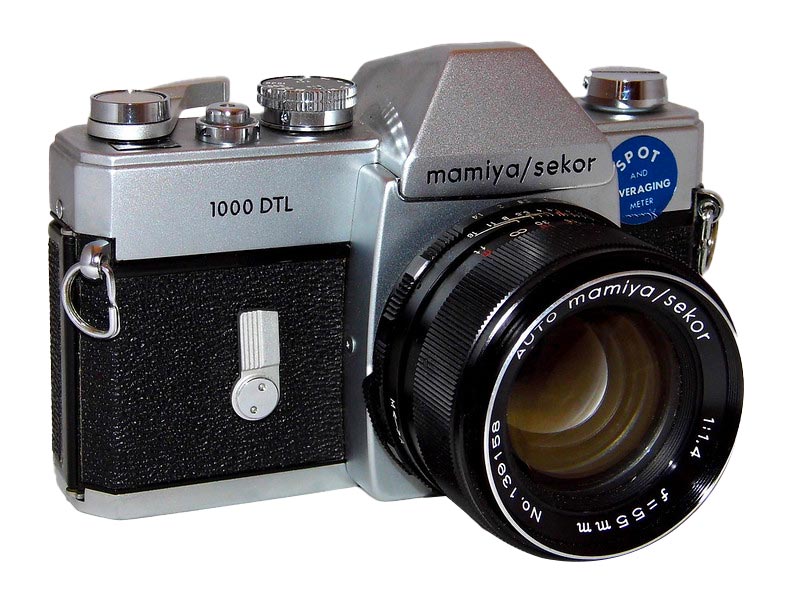
Mamiya standard M42 mount specifications
Mount type: Thread mount (M42x1)
Flange focal distance: 45,46 mm
Film format: 36mm x 24mm (‘Full frame’)
Mount communication (mechanical): aperture stop-down (camera-to-lens);
Adapting Mamiya standard M42 lenses…
Adapting to SLRs:
These lenses are regular M42 auto lenses, meaning that you can adapt them as you would do any M42 lenses by other manufacturers. They will, in effect, function precisely as intended on any auto aperture M42 camera body. Moreover, you can adapt them to a number of other film SLRs (see more details in the JAPB article on the M42 mount).
Mamiya also offered a custom adapter to allow mounting this generation’s lenses on bodies of the XTL (ES) mount cameras.
Adapting to dSLRs:
Thanks to the relatively generous flange focal distance of the M42 mount, M42 lenses can be adapted to most dSLR camera mounts, with the notable exception of the Nikon F mount dSLRs. However, with some full frame dSLRs, some M42 lenses are known to cause issues limiting the free movement of the dSLR mirror. See also the final caveat.
Adapting to mirrorless cameras:
M42 lenses and mirrorless cameras are generally a very trouble-free combination as the only thing needed is a regular dumb adapter. Hence, M42 lenses can typically be adapted to every mirrorless mount available.
Final caveat:
That said, while most of these standard M42 lenses have a switch to select between manual aperture and auto aperture, some of the later models seem to be auto-only. With auto-only M42 lenses, one will need an M42 adapter that has an inner flange that depresses the aperture stop-down pin as the lens’ aperture will otherwise not respond to the aperture ring and will remain fully open.
Identifying Mamiya (standard) M42 mount/lenses
These lenses carry the phrase ‘AUTO mamiya/sekor’ on the lens’ name ring.
Looking at the mount of a Mamiya standard M42 lens, the lens is no different form any other manufacturer’s standard M42 (auto aperture) lens. See more here.
Act 4: The Mamiya XTL/ES mount:
The Mamiya XTL/ mount (typically referred to as either the Mamiya XTL mount or the Mamiya ES mount, sometimes even referred to as the X-mount) was introduced together with the Mamiya/Sekor AutoXTL camera in 1971. The AutoXTL was Mamiya’s attempt to break into the professional segment, and was – for its time – technologically quite advanced.
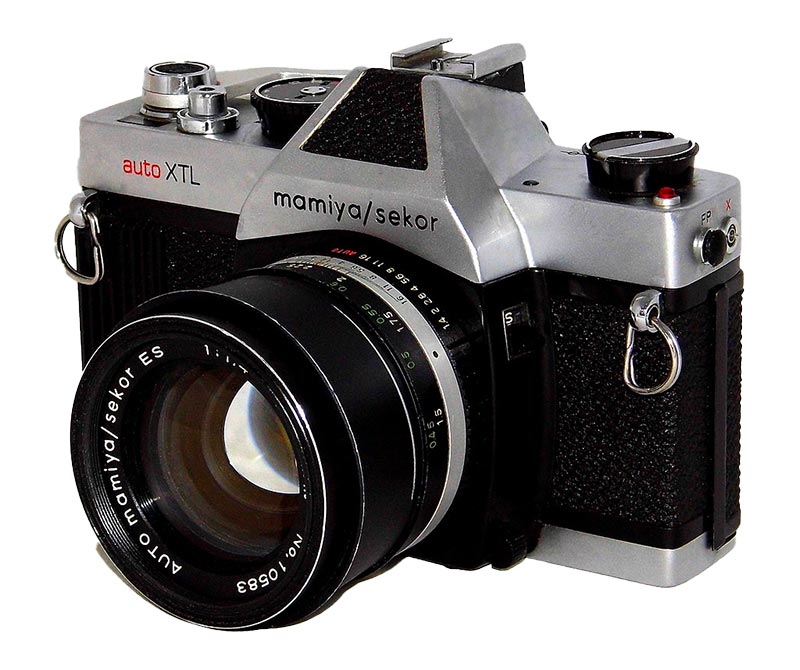
Image credits: Joe Haupt, CC-BY-SA 2.0, link to original (Edits: background removed)
Combining a proprietary bayonet mount, shutter priority AE and a dual spot/average metering system that would meter at the film plane, the Mamiya AutoXTL was maybe a stretch too far for its time. An alternative explanation for why sales fell well short of planned was that Mamiya had misunderstood the pro segment, and had offered automation to a crowd inimical to automation.
Even though the XTL-line of cameras did not sell as well as expected, Mamiya introduced a respectable roster of 13 lenses for the XTL/ES mount, including a 21 mm wide-angle and Mamiya’s first zoom.
Mamiya XTL/ES mount specifications
Mount type: Bayonet (male-type; lens release on body)
Flange focal distance: 44,5 mm
Film format: 36mm x 24mm (‘Full frame’)
Mount communication (mechanical): aperture stop-down lever (camera-to-lens);
Adapting Mamiya XTL/ES mount lenses…
Use on SLRs/dSLRs
The only type of SLR that can natively accept a Mamiya XTL/ES lens is one of the two original Mamiya bodies (the AutoXTL and Auto X-1000). Moreover, based on a study of Mamiya brochures from the mid 70s, it would seem that Mamiya never offered a way to use Mamiya XTL/ES lenses on the next generation Mamiya cameras. While the Mamiya AutoXTL and Auto X-1000 were quality products, they were never produced in really significant numbers. Hence, while these bodies are still available, they are not the easiest finds.
Due to the not-too-generous flange focal distance of the Mamiya XTL/ES mount, adapting Mamiya XTL/ES lenses on dSLRs would necessitate an adapter with optics. Currently no such adapters exist, but that does not guarantee that they would not have been manufactured earlier (and might therefore be available on the 2nd hand market).
Use on mirrorless
In principle, the Mamiya XTL/ES mount is quite straightforward, and there are no significant technological impediments to manufacturing adapters for all modern mirrorless systems.
However, thanks to the relative lack of success of this line of Mamiya cameras, Mamiya XTL/ES adapters are not exactly commonplace. In fact, as of this writing, none of the major adapter manufacturers offer a Mamiya XTL/ES adapter. Even so, some sellers on eBay and Aliexpress seem to try to fill this gap.
Identifying Mamiya XTL/ES mount/lenses
Looking at the front of Mamiya XTL/ES lenses, they all carry the phrase ‘AUTO mamiya/sekor ES’ on their name ring.
Looking at the back…
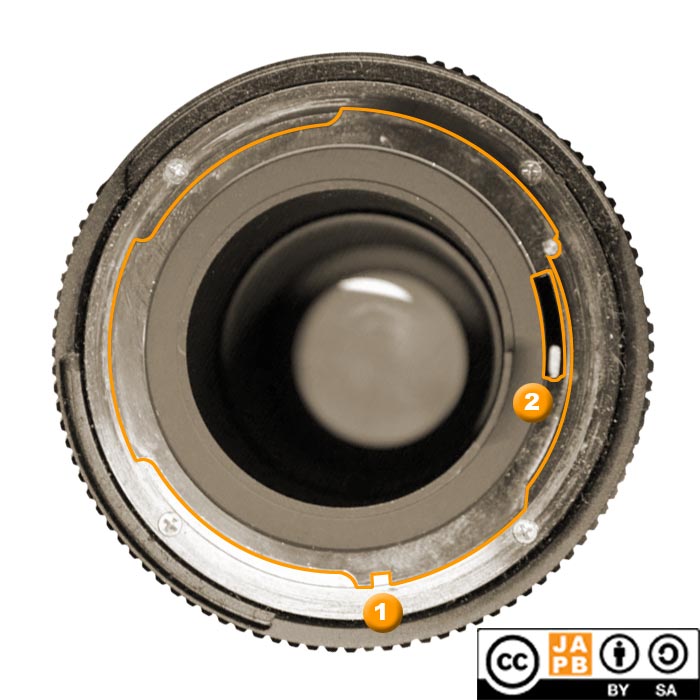
Mamiya XTL/ES mount characteristics:
[1] Three-pronged male bayonet with locking notch at about 05:30
[2] Aperture stop-down lever
Act 5: Mamiya M42/SX lenses
After their relatively lacklustre adventure with a proprietary bayonet mount, Mamiya’s next generation was a return to the roots. At least partially. In 1974 and in tandem with the MSX family of cameras Mamiya relaunched its entire roster of lenses with a M42 mount, but with a twist.
Like Pentax and Fuji before them, Mamiya made proprietary modifications to the standard M42 mount. First, they extended the aperture ring’s ‘skirt’ a bit backwards. Second, they added a pin to the base of the aperture ring, that a compatible camera could ‘read’ to discern which aperture value the photographer had set. These lenses will be referred to here as M42/SX lenses.
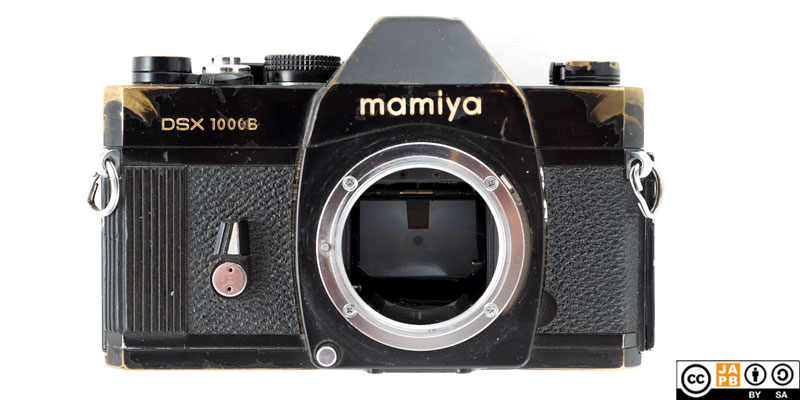
The idea (seemingly) of this move back to the M42 mount was to again have the entire roster of M42 lenses to fall back upon, while still being able to offer attractive functionality (exposure automation) to those consumers using Mamiya’s new bodies and latest lenses, while at the same time hindering the use of these fancy new Mamiya lenses on other manufacturers’ bodies.
These new, M42/SX lenses are systematically named ‘AUTO mamiya/sekor SX’ in differentiation from earlier standard M42 lenses (which are just ‘AUTO mamiya/sekor’)
While Mamiya had some success with the MSX/DSX line of cameras and M42/SX lenses, Mamiya’s 1974 move back to the M42 mount was ill-timed. In 1975 Pentax launched the Pentax K mount and transitioned its new designs to that mount. In the years that followed, practically all Japanese second-tier manufacturers (Chinon, Cosina, etc.) followed suit and transitioned from M42 to Pentax K. Seeing the writing on the wall, Mamiya started preparing a move away from M42…
Mamiya M42/SX mount specifications
Mount type: Thread mount (M42x1)
Flange focal distance: 45,46 mm
Film format: 36mm x 24mm (‘Full frame’)
Mount communication (mechanical): aperture ring position (lens-to-camera); aperture stop-down (camera-to-lens)
Adapting Mamiya M42/SX mount lenses
Use on SLRs/dSLRs:
Given that these lenses were intentionally made to not be usable on other M42 bodies, the only way to use unmodified Mamiya SX M42 lenses on film cameras is to find a functioning Mamiya MSX or DSX camera body. Luckily Mamiya cameras were generally quite well built, and many functioning exemplars are still available.
However, the Mamiya MSX/DSX line was in production for only 4 years, leading to a lot of lenses that were no longer usable on a camera body, unless the lenses were modified. As a result, it is not at all unusual to encounter Mamiya M42/SX lenses that have been modified to remove those parts that have hindered mounting the lens on other M42 bodies and M42 adapters. Such lenses can be used on any functioning M42 camera body in auto aperture mode. Sadly, many of these modifications have used force instead of finesse and I’ve even encountered one instance of a lens that had been rendered mostly unusable due to lack of craftsmanship.
Use on Mirrorless:
On mirrorless using M42/SX lenses is (in principle) easy, assuming you have an adapter that
a) will leave space for the M42/SX lens’ aperture communication pin, and
b) will engage the M42/SX lens’ aperture stop-down pin, either using a custom contraption or a simple internal bezel.
Finding an adapter that ticks both boxes is by no means impossible.
Identifying Mamiya M42/SX mount lenses
Looking at the front of Mamiya M42/SX mount lenses, you can always identify these lenses thanks to the following inscription on the name ring: ‘AUTO mamiya/sekor SX’
Looking at the back…
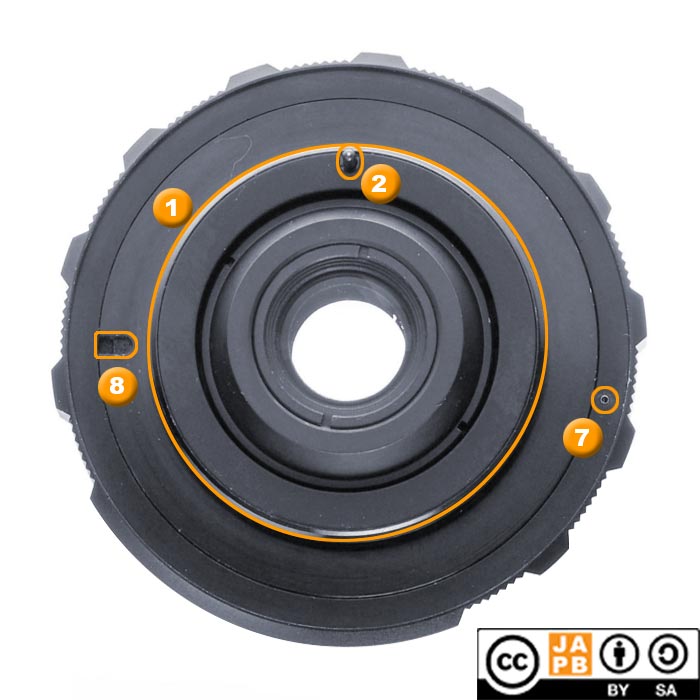
[1] 42 mm diameter thread (with 1.0 mm thread pitch];
[2] pin for stopping down lens to user-defined aperture;
[7] pin in the aperture ring that allows a compatible camera body is able to read the aperture ring position directly (moves with aperture ring);
[8] locking groove in the base of the flange to secure that the lens is mounted at the correct rotational angle.
Act 6: The Mamiya NC/CS mount:
Having been forced to move away from their proprietary variant of the M42 mount, Mamiya in 1978 launched the NC1000 and NC1000s cameras, sporting a new proprietary bayonet mount. This mount is typically referred to either as the NC mount (due to the name of the cameras) or the CS mount (based on the acronym featuring heavily in the names of the lenses).

Together with the new camera, Mamiya launched a set of 9 regular primes ranging from 21 to 300 mm, one fisheye, one macro lens and three zooms. Interestingly, it seems most if not all were entirely new designs and in the coming years they came to be widely highly regarded and many of these designs would be reused in the next generation of Mamiya lenses.
That said, while the lenses themselves were highly regarded, the lens lineup was in some respects less ambitious than the previous (M42 SX) lineup of lenses – most obvious in the lack of any short tele primes (there was a gap between 50 and 135 mm) or super tele lenses (anything longer than 300 mm).
While one could ask why Mamiya did not simply breathe new life into its existing proprietary bayonet mount (the XTL/ES mount) it seems management at Mamiya was either vary of any associations with the failed XTL/ES mount or more concerned with those heavily invested in the M42/SX mount. In any case – besides a lineup of newly designed lenses, Mamiya also introduced a custom adapter to allow mounting M42/SX lenses (and other M42 lenses) on the new NC line of cameras.
In 1980 (only 2 years after the launch of the NC1000) Mamiya introduced the Z-line of cameras, which spelled the end of the NC1000s and its bayonet mount.
Mamiya NC/CS mount specifications
Mount type: Bayonet (male-type; lens release on body)
Flange focal distance: 45,5 mm8
Film format: 36mm x 24mm (‘Full frame’)
Mount communication (mechanical): aperture stop-down pin (camera-to-lens);
Adapting Mamiya NC/CS mount lenses…
On SLRs/dSLRs
If you want to use Mamiya NC/CS mount lenses in their original environment, you will need to find a working Mamiya NC1000(s) body. While these were never produced in copious amounts, neither are they especially rare. Alternatively you can mount your NC/CS mount lens on a Mamiya ZE/ZE-2 body, and these are decently available.
In terms of flange focal distances, Mamiya NC/CS could be adapted to some dSLR mounts without the need for corrective optics, but I have not managed to find a sample of such an adapter. On the other hand, there are Mamiya Z/E adapters with corrective optics for all major dSLR mounts, but I cannot guarantee that these would allow mounting NC/CS lenses or that they would activate the aperture stop-down pin.
On Mirrorless:
In principle, manufacturing an adapter to allow the mounting of Mamiya NC/CS lenses on mirrorless cameras is mechanically very straightforward. However, due to the relative lack of popularity of the NC/CS mount, no major adapter manufacturers offer a NC/CS adapter. That said, there are cottage industry products available on eBay/Aliexpress that promise being able to adapt NC/CS lenses on practically all mirrorless mounts.
Alternatively, it could be possible that some Mamiya Z/E adapters have been manufactured to also allow the adapting of NC/CS lenses, but at least those Mamiya Z/E adapters that I have tried do not allow changing the lens’ aperture…
Identifying Mamiya NC (CS) mount/lenses
Looking at the name ring, Mamiya NC (CS) mount lenses can be conclusively identified by them sporting the phrase ‘AUTO MAMIYA-SEKOR CS’.
Looking at the mount of a Mamiya NC (CS) mount lens:
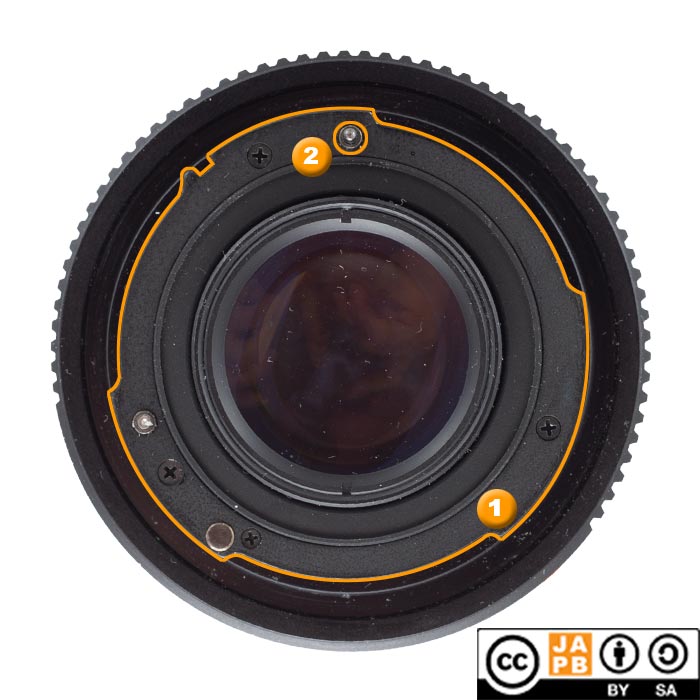
Key characteristics:
[1] Three-pronged male bayonet mount with locking notch at 11:00
[2] Aperture stop-down pin.
Act 7: The Mamiya Z/E mount:
The Mamiya Z/E-mount was introduced in 1980, together with the Mamiya ZE SLR.

The Mamiya Z/E mount was definitely forward looking, as the mount specification included 16 (!) electronic contacts, even while the contemporary Mamiya ZE camera (the first camera in the Mamiya Z-series) used only three of those contacts (the subsequent camera models used six contacts (ZE-2 and ZM) or the full range (ZE-X).
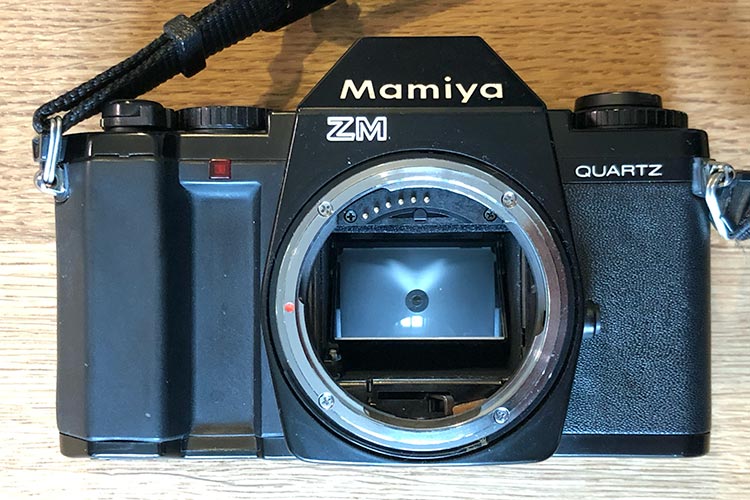
There are three subfamilies of Mamiya Z/E-mount lenses. The earlier Z/E-mount lenses go under the name (Mamiya-Sekor) E, while later lenses (with 11 electronic contacts) go under the name (Mamiya-Sekor EF). The main difference seems to have been the EF lenses were able to communicate (to a compatible body) the focusing distance (something Nikon implemented roughly a decade later in its AF-D lenses).
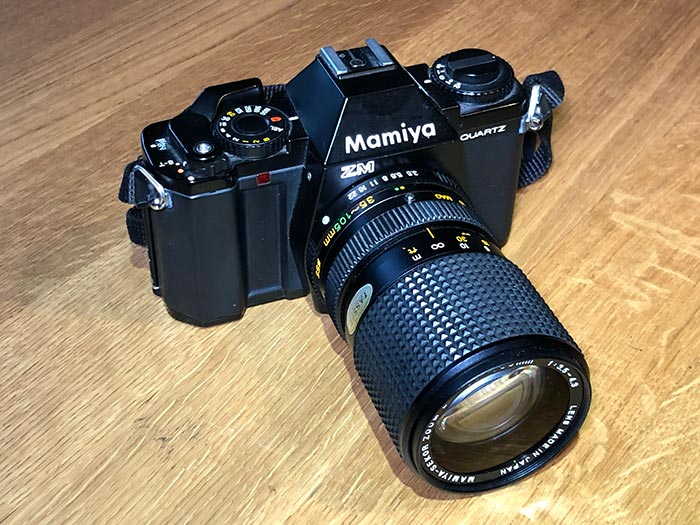
Thirdly, there is a sub-family of Z/E lenses that were known as E”S” or E(S) lenses. The type name of these (based on lens name rings) was special in that the E and S were separated by the core specifics of the lens (As in: “MAMIYA-SEKOR E 50mm 1:1.7 S” This is a significant difference and helps distinguish these lenses from the “mamiya/sekor ES” lenses used by the predecessor series of cameras (Mamiya XTL/X-1000).
I’ve tried to find detailed information regarding what data those electronic contacts would be used to communicate, but with no luck so far. Maybe I’ll have to pick up a multimeter and find out for myself. It is also possible that the core functionality in some of these contacts has been essentially a form of lens coding (I honestly cannot imagine what else a manual lens would need 16 contacts for…) In 1982 there was a rumour that Mamiya was working on an autofocus camera (which would possibly have beaten Minolta to the punch), and that would offer an explanation for including 16 contacts in the mount’s specifications.
There is – however one relatively quirky feature with Mamiya Z/E-lenses: While the lenses sport a classic aperture ring with click stops, that aperture ring actually does very little (it certainly does not manipulate the aperture). Instead, aperture control is based on a) the user selecting an aperture value; b) the lens communicating that value to the camera; the camera stopping down the aperture at the time of shooting.
One interesting aspect of the Mamiya Z/E mount is that it is – sort of – compatible with the Mamiya NC/CS mount, in that you could mount Mamiya NC/CS lenses straight onto a Mamiya ZE/ZE-29 camera, but with a quirk: That such lenses would have limited compatibility (essentially, the lenses would become manual aperture lenses and metering would always be stop-down) and would be mounted at a 90° rotation.
Mamiya Z/E mount specifications
Mount type: Bayonet (male-type; lens release on body)
Flange focal distance: 45,5 mm
Film format: 36mm x 24mm (‘Full frame’)
Mount communication (mechanical): aperture ring position (lens-to-camera); aperture stop-down (camera-to-lens);
Mount communication (electronic): 10/11 electronic contacts. Entire extent of communication (designed/implemented) unknown to JAPB
Adapting Mamiya Z/E lenses
Given the abrupt end of the Mamiya Z camera lineup, Mamiya Z/E lenses have been a prime candidate for adapting for a long time. No surprise therefore, that there are numerous adapters (with optics) available both for dSLR mounts and adapters (without optics) for most mirrorless mounts.
Besides the ordinary caveats related to using adapters with optics, the Mamiya Z/E mount has one quirk up its sleeve in that aperture control is not straightforward (See above). Hence, any Mamiya Z/E adapter must have a ring for controlling the lens’ aperture.
n.B! based on my personal experience with one Mamiya Z/E adapter: Mamiya NC lenses could be mounted on the adapter, but the adapter did not depress the NC lens’ aperture pin, meaning that the lens could only be used wide open…
Identifying Mamiya Z/E mount/lenses
Depending on the generation of Z/E lenses, the lens’ name ring will say either:
• MAMIYA-SEKOR E
• MAMIYA-SEKOR EF
• MAMIYA-SEKOR E [mainline specifications] S
Looking at the mount-end:
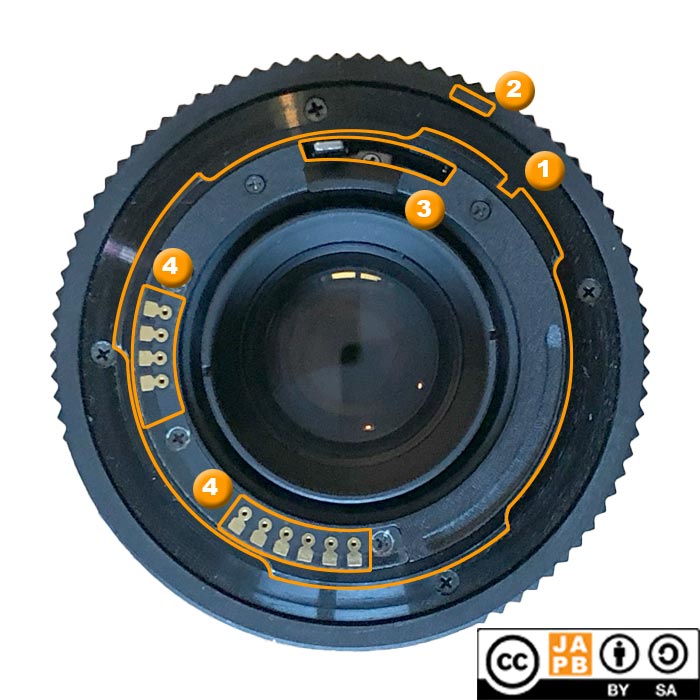
[1] Three-pronged bayonet with tapered edges and lock notch at 01:30.
[2] Aperture communication prong (interacts with camera). Location indicative as moves with aperture ring.
[3] Aperture control lever
[4] Two banks of electronic contacts. 6+4 contacts on E-class lenses; 6+5 contacts on EF-class lenses.
See more here.
Footnotes:
- For comparison (1961–1980):
Nikon: 1 mount (Nikon F)
Minolta: 1 mount (Minolta SR)
Olympus: 1–2 mounts (Olympus OM and Pen F)
Pentax: 2 mounts (M42 and Pentax K)
Konica: 2 mounts (Konica F and Konica AR)
Topcon: 2 mounts (Topcon RE and Topcon UV)
Yashica: 3 mounts (Pentamatic, M42, Contax/Yashica)
Canon: 4 mounts (R, FL, FD, and FDn) ↩︎ - Mamiya often tried to take care to offer some form of backward compatibility through offering a decent range of adapter rings to allow mounting older lenses on newer bodies. Sometimes newer bodies would also accept older mount lenses directly. ↩︎
- Mamiya was not the only camera maker to initially place their bets on the Exakta Mount. Fellow compatriot Topcon (Tokyo Kogaku, company profile here) did so with significant success… ↩︎
- Even calling it the XTL/ES mount will leave those who like to call it the ‘Mamiya X mount’ dissatisfied… Oh well… ↩︎
- The proprietary addition made to the M42 mount in the SX line of lenses is the addition of a pin that travels together with the aperture ring, which the body could then use to read the selected aperture (thereby enabling metered aperture priority). As such, this implementation is very reminiscent of the similar addition Fujinon made to its M42 lenses.
Problematically, this pin (and the aperture ring that extended further towards the camera) preclude mounting Mamiya SX lenses on both most M42 cameras and a fair share M42 adapters. ↩︎ - The […] would typically contain the lens’ basic specifications: focal length and maximum aperture. The kit lens would therefore read: “MAMIYA-SEKOR E 50mm 1:1.8 S” (the “S” would be in red). ↩︎
- Some examples of manufacturers introducing a leaf shutter SLR: the Topcon UV series, the Kodak Retina Reflex family, the Voigtländer Bessamatic/Ultramatic family [more info here]. Even the Soviets tried marketing a leaf shutter SLR [more info here]. ↩︎
- There seems to be persistent misinformation online regarding the flange focal distance of the Mamiya NC and Mamiya Z mounts, as some sources say 45,5 mm and others say 43,5 mm (and one even saying 45,54 mm). As far as I could make out using a digital caliper and my two Mamiya Z mount cameras, the value of 45,5 mm seems more likely. ↩︎
- This compatibility seems to have been dropped in the ZE-X and ZM bodies. ↩︎